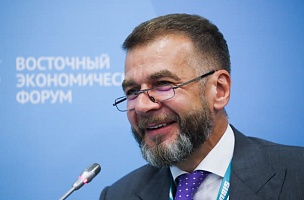During the plenary discussion ‘Status of the Implementation of the
Global Tiger Recovery Programme for the Period from 2010 to 2022’, which was
held as part of the 2nd International Tiger Forum, the countries
that are home to this rare predator shared their experience over the past 12
years and their plans for the future.
Russian President Vladimir Putin greeted the Tiger Forum
participants with a video message.
“The goal of bolstering international cooperation and
exchanging experience with those who have achieved success in the conservation
of the tiger is of paramount importance. I am pleased to note the achievements
of our colleagues from India, Nepal, Bhutan, and China, where the populations
of this large wild cat are growing steadily. In Russia, we also have a lot to
be proud of. Twelve years ago, there were no more than 390 adult Amur tigers living
in our Far Eastern taiga. Now there are around 750 of them along with their
cubs. This is the result of systematic measures that have been implemented at
the state level, but above all, it’s a visible manifestation of the
well-coordinated, hard work performed by Russian scientists, enthusiasts, and
environmental organizations,” Putin said.
Konstantin Chuychenko, who also chairs the Organizing
Committee of the 2nd International Tiger Forum as well as the
Supervisory Board of the Amur Tiger Centre, delivered a welcome address.
“I would like to express my confidence that this Forum
will boost the international community’s attention to the issue of tiger
conservation. We truly need to act together because the tiger is a wonderful
noble predator that knows no borders between states. So we can only achieve
success through our collective efforts. We must work together to address the
threats that continue to exist today. And I think together we will win,” Chuychenko
said.
In his speech, Russian Minister of Natural Resources and Environment Alexander
Kozlov noted that over the past 12 years not only has the tiger population
grown, but the habitat of this rare predator has also expanded. Whereas in the
past only the Primorye region and the Khabarovsk Territory were home to tigers,
the predators now live in the Jewish Autonomous Region and the Amur Region. The
range of their habitat has increased to almost 186,000 square kilometres.
“Thirteen countries are the guardians of the last
remaining tigers in the wild. The predator’s future truly depends on all of us
and each of us. We are obligated to maintain a balance and treat all living
things with respect,” Kozlov said.
During the recap of the last 12 years of tiger conservation activities,
the measures taken in Russia were announced. Liability for crimes against
tigers were introduced to the criminal code in 2013, and the punishment for
these crimes was toughened in 2019. A system to protect tigers and their food
supply has been created by the services that are in charge of protecting wildlife
in the regions inhabited by the rare predator. New specially protected natural areas
have been created. Work is under way to resolve conflicts involving tigers and
humans, and a programme has been introduced to compensate farmers who suffer
losses from the actions of tigers. A system for the rehabilitation and
reintroduction of the tiger is also functioning, and large-scale awareness work
is under way.
Chuychenko and Kozlov announced the
goals over the next 12 years to protect the Amur tiger in Russia.
“Today, we have reached a comfortable number of animals.
Now the goal is to expand the tiger’s range and get closer to its historical
borders. The increased density of tigers leads to more conflict situations with
humans. Overall, the so-called ‘games with Amur tiger numbers’ have not had very
good results because the tiger determines its own density. And if tigers feel cramped,
they simply don’t get along with each other, but spread out, as they say,” Chuychenko
said.
In addition, when it comes to protecting tigers, he noted that it is crucial
to understand that they are at the top of the food chain and we must consider the
state of the taiga and forests in which they live as well as the ungulates,
which form the basis of their diet, to ensure that they can live and reproduce
comfortably. Russia’s Hunting Surveillance Service (Okhotnadzor), which is the
primary defender of the tiger and is currently well equipped, should not be
disregarded. In 2020, Okhotnadzor opened a property complex in Ussuriysk, and a
similar complex will be built in the Khabarovsk Territory in the near future.
Kozlov stressed that tigers do not know national
borders, so it is important to strengthen cooperation with border countries
through specially protected natural areas. At present, Russia and China are
discussing the creation of the Land of Big Cats transboundary reserve. Today,
it is already home to 25 predators. Special attention needs to be paid to the
risks that tigers face and ways to minimize them when developing projects and
programmes for the socioeconomic development of the Far East, which may affect
lands that do not have a protected status, but are included in the tiger’s home
range.
Pine nuts will be included in the List of
Strategically Important Goods and Resources, which will effectively combat the smuggling
of pine nuts across the customs border of the Eurasian Economic Union and, consequently,
affect its production volume and reduce it to an optimal level.
Particular attention will be paid to combatting poaching. The further
tightening of penalties for crimes against rare animals and harmonizing laws
against violators as much as possible in all countries where tigers roam will
help improve the situation.
Tigers held in captivity in adverse conditions also need to be
addressed. Plans are in the works on a truly effective mechanism to prosecute
people for animal cruelty.
North Korea
Ambassador Extraordinary and Plenipotentiary of the Democratic People’s
Republic of Korea to the Russian Federation Sin Hong Chol noted that the tiger
is a symbol of the Korean nation and that North Korea is working to
significantly restore its habitat and create a legal framework for the
protection of rare and endangered animals. North Korea advocates cooperation
between border states for the sake of the tiger, primarily with Russia and
China.
India
Satya Prakash Yadav, member secretary of India’s
National Tiger Conservation Authority (NTCA), shared his positive experience in
preserving and increasing the tiger population in India, where the tiger
population has doubled over the past 12 years.
“India is the country with the largest number of
tigers in the world, where the tiger is the national animal. We are home to
approximately 70% of the entire population. Since 2010, we have seen stable
growth. It is growing by about 6% per year,” Yadav said.
In an effort to maintain and increase the tiger population, India
believes it is essential to pay special attention to sources of clean water.
During the reporting period, approximately 350 different sources of water
pollution were eliminated in the country, which significantly contributed to conserving
the population of this species of predators.
India has been engaged in tiger conservation efforts since 1973 and is
currently home to 52 reserves, which cover 40% of its range in India. These
substantial results in increasing the number tigers have been achieved thanks
to a combination of various measures: taking into account the best practices
for tiger conservation, monitoring the use of camera traps, recording the
mortality rate of all tigers, working with reserve staff, a special methodology
used to record all conflicts between humans and tigers, special standards to
combat smuggling, and a strategy of buffer zones and corridors for tigers.
Almost every year, the Indian government allocates USD 60–80 million for
these measures, of which USD 4.5 million are spent on creating jobs.
The number of tigers has now increased and, given India’s population,
conflict resolution is one of the most difficult tasks in managing their
population. India has established special requirements and protocols for this
purpose that indicate what people should do if tigers enter the areas where
they live. There is also a warning system in place and special groups that are
deployed to the sites of conflict situations.
Myanmar
Myanmar estimates that it is home to 36 tigers. Myanmar Minister of
Natural Resources and Environmental Conservation Khin Maung Yi spoke
about the measures his country has taken to protect tigers.
“We are actively engaged in the conservation of the
tiger population using modern technologies and work together with international
government organizations and NPOs that combat the illegal capture and trade of
tigers. Myanmar now has 58 protected areas, which cover almost half of the country’s
total area. Tigers inhabit 7% of the country’s territory. Myanmar has developed
a national tiger protection programme that aims to increase its population,” Yi
said.
The country needs USD 10 million to fully implement its national tiger
conservation plan for the period until 2028 and currently has earmarked roughly
half of this amount.
Nepal
Ram Chandra Kandel, Director General of the
Department of National Parks and Wildlife Conservation within the Nepalese
Ministry of Forestry and Environment, also shared his country’s successful
experience with tiger conservation. Nepal is one of the leaders in terms of the
growth of this rare predator’s population numbers. In 2010, Nepal was home to
120–150 tigers and set the goal of doubling their population.
“Over these past 12 years, we not only managed to
double the tiger population, but also surpassed these figures. Today, we have
over 300 tigers. This is indeed a great achievement. In our country, there are
three main protected areas where tigers live. They make up 23% of the country’s
territory,” Kandel said.
Nepal has been involved in biodiversity conservation since the 1970s.
Since 2010, it has intensified its tiger protection measures. The growth in
tiger population has been possible due to the use of various mechanisms,
including combatting illegal trade in tigers at the highest political level and
protecting the boundaries of national parks. Nepal has also paid much attention
to working with local residents affected by tigers. The country has developed
special compensation mechanisms to make payments to the population if tigers
damage their crops or kill livestock. Nepal works closely with India to protect
and increase the tiger population.
Having achieved these results, Nepal plans to focus its efforts on
maintaining the food supply for tigers, expanding their range, protecting the
boundaries of national parks, as well as minimizing any damage caused to tigers
by infrastructure development.
Thailand
Thailand faces a difficult situation with its tiger population due to
their illegal capture and the trade of their body parts, as well as
insufficient food supply in a number of protected areas. The current population
is estimated at 148–189 tigers. The country plans to work to maintain the
quality of its existing tiger habitats, while expanding other areas where the
striped predators have not been sighted in the past 10 years. The country is
also considering the possibility of reintroducing tigers.
Laos
Laos is a member country of the Forum, although tigers have disappeared
there completely over the past 12 years, unfortunately. However, the state is
not giving up and plans to reintroduce tigers. Laos has already allocated 70%
of forest areas to support a new tiger population and plans to use predators
that are being held in captivity to achieve this goal. It is also working
actively to raise awareness among the population and eliminate hunting for these
rare animals.
Laotian Deputy Minister of Agriculture and Forestry Thongphath Vongmany
noted that his country is closely cooperating with all countries within the
tiger home range and is trying to comply with international standards and
requirements in matters concerning protected natural areas. Laos has made
improvements to its environmental protection legislation for this purpose.
Bangladesh
Bangladesh has seen a slight increase in its tiger population. As of
2018, the country was home to 114 tigers, an 8% increase from 2014. Based on
estimates of the available food supply, up to 200 tigers could live in the
forests of Bangladesh.
Amir Hosain Chowdhury, the chief forest officer at the
Ministry of Environment, Forest, and Climate Change of Bangladesh, said the
country’s prime minister is making every effort to conserve forests and biodiversity.
“The Bangladesh government has amended its constitution
and designated 18 territories as specially protected areas. In 2012, Bangladesh
passed the Wildlife Protection Act and introduced severe criminal penalties for
killing tigers. A national tiger conservation committee was also established
under the auspices of the Ministry of Environment, Forest, and Climate Change.
Since 2020, tree felling has been reduced in these territories and the area of
land on which hunting is allowed has been decreased,” Chowdhury said.
Bangladesh is also implementing various measures to resolve conflict
situations between tigers and humans. In 2021, a reporting system was launched
in which people can report such cases and receive assistance.
Vietnam
Pham Van Dien, deputy general director of the
Administration of Forestry of the Vietnamese Ministry of Agriculture and Rural Development,
said roughly 30 tigers live in seven protected areas in the country.
Dien also spoke about how Vietnam has introduced new legislation to
protect the tiger. In 2018, a law criminalizing poaching came into force. In
2014, the country adopted a national tiger protection programme for 2018–2020.
“Tigers can move across very large areas, and we
border on China, Cambodia, and Laos. This is all tiger range, so it is crucial for
us to cooperate and join efforts to preserve the tiger population despite the
borders between the countries,” Dien said.
Cambodia
In Cambodia,
just like in Laos, the tiger is technically considered to be extinct. A
reintroduction programme needs to be developed and implemented in order to
restore the tiger population. At present, the country has allocated two
protected zones with total area of 10,000 square kilometres, which can be
used to reintroduce the animals. To this end, Cambodia plans work closely with
the border countries of the tiger range, NPOs, and international environmental
organizations, as well as step up interaction with local communities. The
Cambodia representative also proposed establishing a special fund to finance
tiger conservation projects, equip transboundary corridors for the movement of
tigers, and improve the quality of monitoring.
Kazakhstan
Kazakhstan also intends to launch a tiger reintroduction programme. The
Kazakh Ministry of Ecology, Geology, and Natural Resources signed a memorandum
of cooperation on this issue with the Russian Ministry of Natural Resources and
Environment during the Tiger Forum.
“For Kazakhstan, this is actually a very large
programme. As a member of the Convention on the Conservation of Biodiversity,
we care about the conservation and restoration of ecosystem. Considering that
the tiger was still present on the territory of Kazakhstan in the middle of the
last century, we have decided to recreate and reintroduce the tiger population
in the exact same area where it existed before. We are at the beginning of our
journey now,” Deputy Minister of Ecology, Geology, and Natural Resources Aliya
Shalabekova said.
The representative of Kazakhstan expressed hope that by 2025, the
country will create a sufficient food supply base and restore the forests
needed to reintroduce the tiger. The programme has been under development
since 2010. At present, a special protected natural area has been created in
Kazakhstan near Lake Balkhash, with a total area of 415,000 hectares. Today,
this reserve is home to around 45 mammal species, 280 bird species, and 420
plant species. Amur tigers native to Primorye are expected to be the first
striped predators to set foot on these lands.
The final document of the 2nd International Tiger Forum was
the Declaration on Tiger Restoration and Conservation. It was adopted by all
the Forum participants.
A recording of the plenary session is available at: tigerforum2022.com/programme/business-programme
The 2nd International Tiger Forum was organized by the
Russian Ministry of Justice, the Russian Ministry of Natural Resources and
Environment, the Amur Tiger Centre, and the Roscongress Foundation.
Photo by Stanislav Krasilnikov / TASS Host Photo Agency






